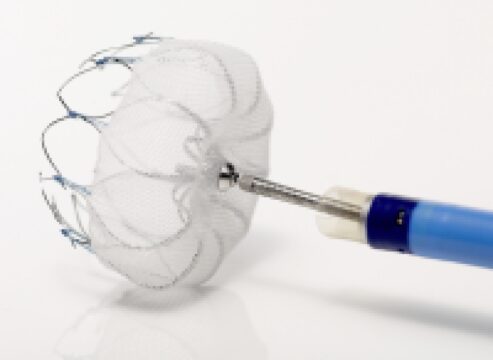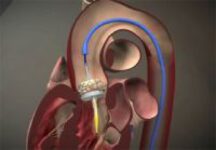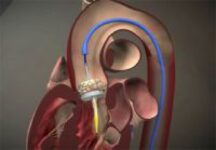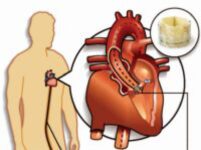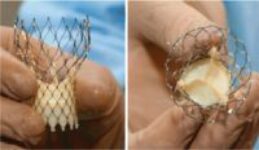Original title: Percutaneous Left Atrial Appendage Closure for Stroke Prophylaxis in Patients With Atrial Fibrillation: 2.3-Year Follow-up of the PROTECT AF (Watchman Left Atrial Appendage System for Embolic Protection in Patients With Atrial Fibrillation) Trial. Reference: Vivek Y. Reddy et al. Circulation. 2013;127:720-729. Atrial fibrillation is the most common sustained arrhythmia in the world and its importance lies…
TAVI also for pure aortic insufficiency
Original title: Transcatheter Aortic Valve Implantation for Pure Severe Native Aortic Valve Regurgitation. Reference: David A. Roy et al. J Am Coll Cardiol 2013. Article in press. Percutaneous aortic valve replacement (TAVI) has become a standard treatment for patients with severe aortic stenosis and a high surgical risk. However for those patients who have pure aortic insufficiency, (failure…
Favorable outcomes at 5 years post TAVI.
Original title: 5-Year Outcome After Aortic Valve Implantation Reference: Stefan Toggweiler, et al. J Am Coll Cardiol 2013;61:413–9 Percutaneous aortic valve implantation (TAVI) is now a valid strategy as we know its short and medium term evolution but we do not have enough information available about the long term. The aim of this study was to analyze the…
TAVI and cardiac tamponade, a rare but serious complication.
Original title: Incidence, Management and Outcomes of Cardiac Tamponade During Transcatheter Aortic Valve Implantation Reference: Ahmed Rezq et al. J Am Coll Cardiol Intv 2012;5:1264 –72 Transcatheter Aortic Valve Implantation (TAVI) for high risk patients is a valid strategy today but not without complications. Among these is cardiac tamponade, still rare but important because of its implication. There…
Post TAVI LVEF Improvement: Only with No New Conduction Defects
Original title: Impact of a New Conduction Defect Alter Transcatheter Aortic Valve Implantation on Left Ventricular Function Reference: Rainer Hoffmann, et al. J Am Coll Cardiol Intv 2012;5:1257– 63. TAVI development in high risk patients can produce new conduction defects and require a definitive pacemaker in almost a third of treated patients. The aim of this study was…
Transfemoral Transcatheter Aortic Valve Implantation: more experience and better results.
Original title: Trends in outcome after transfemoral transcatheter aortic valve implantation. Pooled-RotterdAm-Milano-Toulouse In Collaboration Plus (PRAGMATICPlus) initiative. Reference: Nicolas M. Van Mieghem et al. Am Heart J 2012;0:1-10. Article in press. Since its introduction in 2002, Transfemoral Transcatheter Aortic Valve Implantation (TAVI) has turned into a viable and safe strategy to treat patients with severe acute stenosis and…
Aortic insufficiency has a poor prognosis in TAVI.
Original title: Impact of Post-Procedural Aortic Regurgitation on Mortality Alter Trancatheter Aortic Valve Implantation Reference: Kentaro Hayashida, et al. J Am Coll Interv 2012;5:1247-56 Transcatheter aortic valve implantation (TAVI) sprung up as a valid strategy to treat patients with severe high risk AS (aortic stenosis). However, residual aortic regurgitation (post AR) and post-dilation remain unsolved. Between October 2006…
The largest published series of valve-in-valve with Core Valve, (Medtronic).
Original title: Valve-in-Valve Implantation of Medtronic CoreValve Prosthesis in Patients with Failing Bioprosthetic Aortic Valves. Reference: Axel Linke el al. Circ Cardiovasc Interv. 2012;5:689-697. This study evaluates the safety, feasibility and results of Core Valve implants on patients with bioprostheses dysfunctional by stenosis, insufficiency or a combination of both. Biological prostheses are preferred over mechanical ones for patients…
Vascular complications after valvular replacement using catheter: PARTNER trial findings
Reference: Généreux, et al, for the PARTNER Trial Investigators. JACC 2012; 60 (12):1043-62 Original title: Vascular complications after Transcatheter Aortic Valve Replacement: Insights From the PARTNER (Placement of AoRTic TraNscathetER Valve) Trial The purpose of the study was to investigate the incidence, predictors and vascular complications impact after catheter aortic valve implantation (TAVI) in the PARTNER…
TAVI, more risky in patients with peripheral vascular disease
Reference: Sinning et al. AHJ Am Heart J 2012;164:102-110 Percutaneous aortic valve replacement (TAVI) is a novel technique for the treatment of severe aortic stenosis (SAS) that has been built with great enthusiasm in clinical practice, particularly in patients with excessive surgical risk. In these patients, a high obstructive peripheral vascular disease stands, a fact…
The impact of permanent pacemaker implantation in patients undergoing percutaneous aortic valve replacement.
Reference: Buellesfeld y colaboradores (JACC in press). Percutaneous aortic valve replacement (AVR) is an innovative technique for the treatment of severe aortic stenosis (SAS); this technique has been incorporated with great enthusiasm in clinical practice, particularly for patients with excessive surgical risks. Due to the proximity of the aortic valve, AV node and His bundle, there…
